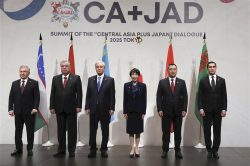- Yomiuri Editorial
- Slowdown in U.S. rate hikes
World watches as Fed adjusts policy, hoping to avert economic downturn
12:45 JST, December 16, 2022
Will the priority be on curbing inflation or shoring up the economy? The U.S. Federal Reserve Board is facing increasing difficulties in steering its monetary policy. The Fed needs to carefully analyze price trends and manage its policy flexibly.
The Fed has decided to raise its benchmark interest rate by 0.5 percentage point to reach a target federal funds rate in a range between 4.25% and 4.50%. The key interest rate has risen to its highest level in 15 years, since 2007.
The Fed lifted its policy of a virtually zero interest rate in March and began raising interest rates. Since June, the central bank has implemented four consecutive 0.75-point interest rate increases — each of them three times greater than the previously ordinary increment. But now it has scaled back its interest rate hikes for the first time.
As to why the central bank slowed down the pace of its interest rate hikes, Fed Chair Jerome Powell said at a press conference that the Fed took into account “the lags with which monetary policy affects economic activity and inflation.”
Typically, it is said to take more than six months for the effects of monetary tightening on business and individual behavior to become clear. Already, soaring mortgage rates have depressed home sales in the United States. It is reasonable that the Fed made a decision to closely monitor the effects of a rate hike.
The focus from now on will be on how far the Fed will raise the key interest rate. Inflation is showing signs of abating, with the rate of increase in the U.S. consumer price index falling to 7.1% in November from a year earlier.
However, Powell stressed his willingness to keep raising interest rates, saying, “It will take substantially more evidence to give confidence that inflation is on a sustained downward path.”
While job openings are increasing due to economic recovery from the coronavirus pandemic, people who had left their jobs have been slow to return and labor shortages have been serious. The situation in which such factors cause wages to rise and push up prices has not changed. Under these circumstances, the burden is concentrated particularly on low-income earners.
Powell probably places more emphasis on curbing inflation than shoring up the economy.
The Fed raised its forecast for the key interest rate at the end of 2023 to 5.1%, up from September projections of 4.6%. The figure is seen as the Fed indicating the final level of interest rates to be reached through its rate hikes.
On the other hand, the Fed sharply reduced its forecast of real gross domestic product growth for the October-December 2023 quarter to 0.5% year-on-year from the 1.2% it forecast in September. This appears to be an indication by the Fed that higher interest rates will inevitably cool the economy.
The damage to the world would be enormous if its largest economy, that of the United States, were to stall. For example, Japan’s exports of automobiles and machinery would decline, a major risk factor for the nation’s economy.
A sharp deterioration in the U.S. economy needs to be prevented. The Fed should adjust the pace of interest rate hikes appropriately.
(From The Yomiuri Shimbun, Dec. 16, 2022)
"Editorial & Columns" POPULAR ARTICLE
-

Violations of Subcontract Law: Major Automakers Must Eliminate Old Practices
-

Local Governments’ Tax Revenues: Devise Ways to Correct Imbalances in Tax Sources
-

5 Japanese Business Dinner Mistakes to Avoid — and What They Taught Me About Business in Japan
-

Heavy Rains in Asia: Support for Victims, Flood-Control Measures Urgently Needed
-

New Nuclear Threat: China Seeking to Follow U.S., Russia in Military Expansion
JN ACCESS RANKING
-

Keidanren Chairman Yoshinobu Tsutsui Visits Kashiwazaki-Kariwa Nuclear Power Plant; Inspects New Emergency Safety System
-

Imports of Rare Earths from China Facing Delays, May Be Caused by Deterioration of Japan-China Relations
-

University of Tokyo Professor Discusses Japanese Economic Security in Interview Ahead of Forum
-

Japan Pulls out of Vietnam Nuclear Project, Complicating Hanoi’s Power Plans
-

Govt Aims to Expand NISA Program Lineup, Abolish Age Restriction




















